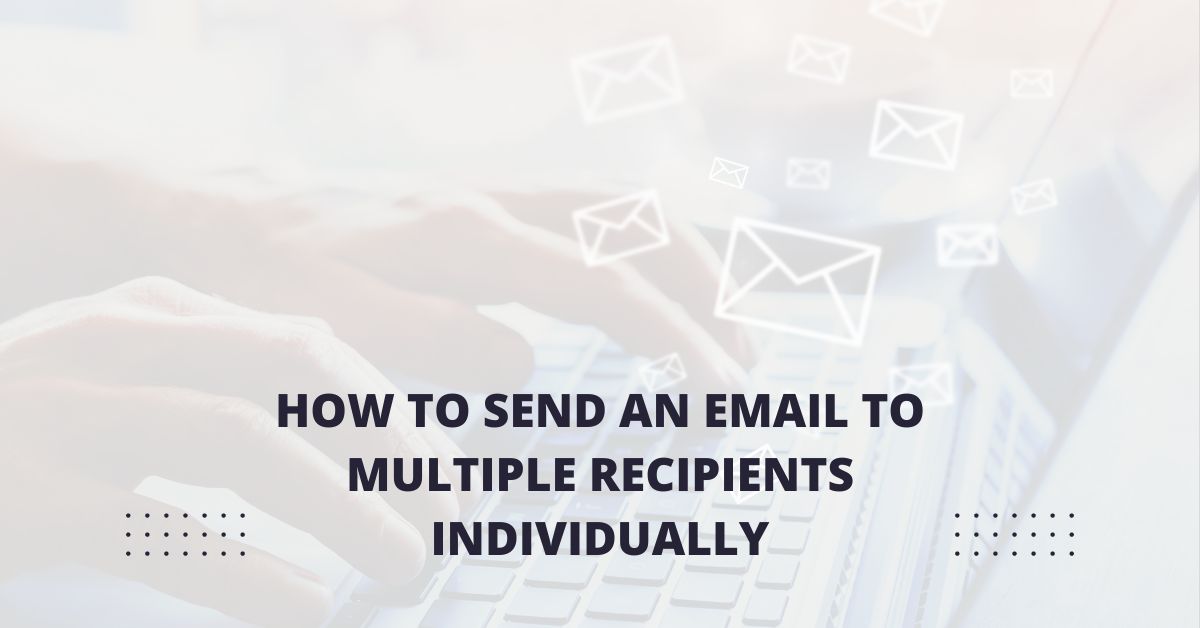In today’s fast-paced world, email has become an essential mode of communication for individuals and businesses alike. Often, there arise situations where you need to send the same message to multiple recipients, but you want each email to appear personalized and unique.
Whether you are sending invitations, business proposals, marketing campaigns, or updates to your team members, sending individual emails has its advantages. It shows that you value each recipient and are willing to invest time in crafting a tailored message for them.
This comprehensive guide will walk you through the process of sending an email to multiple recipients individually, ensuring that your communication is effective and engaging.
Benefits of Sending Individual Emails
Sending individual emails instead of a bulk email has several significant benefits that can positively impact your communication and relationships:
- Personal Touch: By addressing each recipient personally, you establish a stronger connection. People are more likely to respond to emails that are specifically tailored to them, rather than generic mass emails.
- Higher Open and Response Rates: Personalized emails have higher chances of being opened and read. Recipients are more likely to respond positively to content that speaks directly to their needs and interests.
- Building Trust and Credibility: When recipients receive an email that addresses them individually, it reflects professionalism and attention to detail. This can enhance your credibility and build trust with your audience.
- Avoiding the “Reply All” Dilemma: Using the “Bcc” field to send individual emails ensures that recipients’ email addresses remain private. This prevents any awkward situations that might arise from someone accidentally hitting “Reply All.”
- Higher Conversion Rates: In marketing campaigns, personalized emails have been shown to lead to higher conversion rates compared to generic mass emails.
- Effective Communication: When you send individual emails, you can focus on conveying your message more effectively without worrying about overwhelming recipients with irrelevant information.
Steps To Send an Email to Multiple Recipients Individually
Step 1: Compose Your Email
Before addressing multiple recipients, compose the content of your email. Start with a warm and personalized greeting that includes the recipient’s name. Introduce yourself or remind the recipient of your previous interactions, if applicable. Clearly state the purpose of your email and what you hope to achieve with this communication. Be concise, direct, and engaging in your writing.
Step 2: Add Recipients
To send individual emails, you should utilize the “Bcc” (Blind Carbon Copy) field in your email client. The “Bcc” field allows you to add multiple recipients without revealing their email addresses to others. This maintains the privacy of your recipients and prevents a cluttered inbox for everyone involved. Remember to separate each recipient’s email address with a comma.
Step 3: Personalize the Email
Personalization is the key to making your recipients feel valued and appreciated. Address each individual by their first name at the beginning of the email. If possible, include specific details related to their interests, previous interactions, or any personalization tokens you may have collected. For example, if you met the recipient at an event, refer to that meeting in your email to create a personalized touch.
Step 4: Review and Send
Before hitting the send button, take a moment to review your email. Check for any typos, grammatical errors, or broken links. Ensure that you have included all the necessary information for each recipient and that you have addressed them correctly. Sending personalized emails with mistakes can be counterproductive, so it’s essential to double-check your content.
Tips for Efficiently Sending Individual Emails
- Use Email Templates: Create email templates for different scenarios to save time while maintaining consistency in your messaging. However, always personalize the templates before sending.
- Utilize Mail Merge: For large-scale email campaigns, consider using mail merge tools or plugins that allow you to personalize each email efficiently.
- Avoid Spam Filters: Refrain from using spammy words or phrases that might trigger spam filters. Craft your emails to be informative and relevant to your recipients.
- Segment Your Recipients: If you have a diverse group of recipients, consider segmenting them based on their interests or demographics. This allows you to create more targeted and relevant emails.
- Include a Clear Call-to-Action (CTA): State what action you want the recipient to take after reading the email. Whether it’s replying to an email, visiting a website, or making a purchase, a clear CTA can improve response rates.
- Respect Privacy and Permissions: Ensure that you have the recipient’s permission to send them emails, especially if they are not already part of your contact list.
- Test Before Sending: Send test emails to yourself or a colleague to check how the email appears to recipients. Ensure that formatting, images, and links work correctly.
So, this was all about sending individual emails like a pro! By personalizing your messages and using the “Bcc” field for privacy, you’ll make each recipient feel valued and create stronger connections. Keep those emails engaging and steer clear of spam filters to ensure your messages land in the right inbox. Now, it’s time to put your newfound skills to use and watch your communication game reach new heights! Happy emailing
Also check: How To Remove Google Account From Phone
